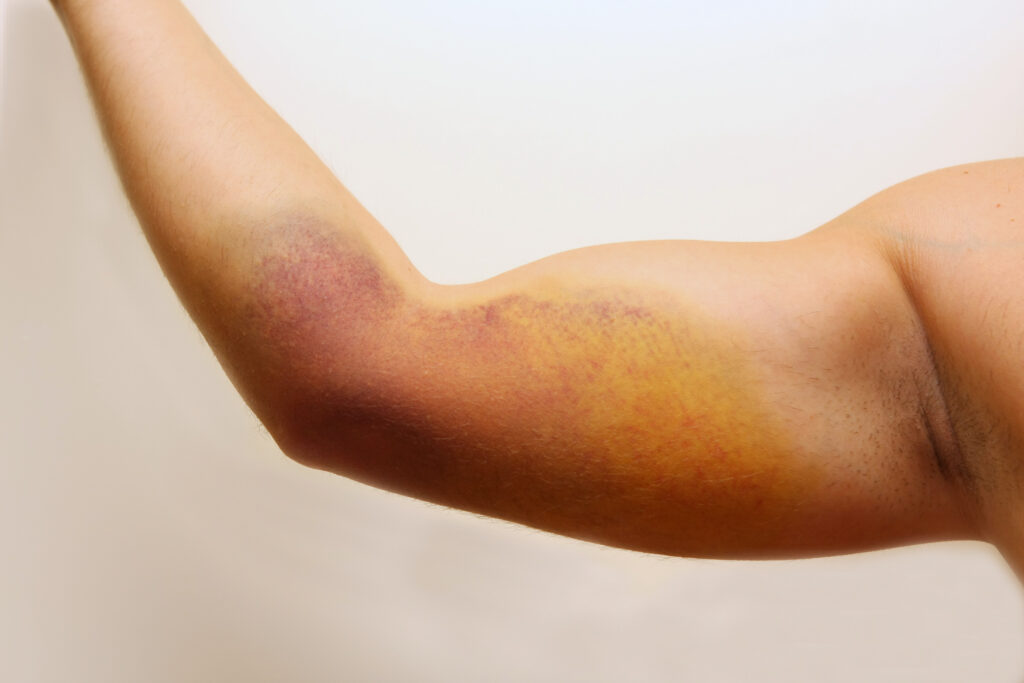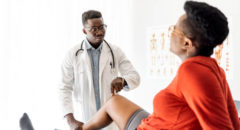
You may not hear much about blood clots, but they are a serious health condition that can even be fatal. Deep vein thrombosis, or DVT, is a blood clot that forms in a vein deep in the body. Blood clots occur when blood thickens and clumps together.
These clots can happen anywhere in the body, that's why it's important to pay attention to the signs all over your body.
Blood clots may dissolve on their own, but if they don't and are left untreated, the clots can detach and travel through your bloodstream to your lungs, blocking blood flow and causing pulmonary embolism.
Blood Clot in Your Leg
Protect yourself and know these nine potentially life-threatening warning symptoms of a blood clot:
1. Swelling
This can happen in the exact spot where the blood clot forms, or your entire leg or arm could puff up.
2. Your Skin Changes Color
You might notice that your arm or leg takes on a red or blue tinge, or gets warm or itchy.
3. A Different Kind of Pain
As the clot gets worse, you may hurt or get sore. The feeling can range from a dull ache to intense pain.
4. Lower leg cramp
If the clot is in your calf or lower leg, you may feel like you have a cramp or charley horse.
Your symptoms of a leg blood clot will depend on the size of the clot. That’s why you might not have any symptoms, or you might only have minor calf swelling without a lot of pain. If the clot is large, your entire leg could become swollen with extensive pain.
Blood Clot in Your Lungs
A blood clot that travels to your lungs is called a pulmonary embolism (PE).
Symptoms that could be a sign of a PE are:
1. Pain or tenderness
Throbbing or cramping pain in the arm
2. Swelling
Sudden swelling in the arm
3. Redness
Reddish skin in the arm
4. Warmth
Warm feeling in the arm
5. Bulging veins
Bulging veins in the arm that make your veins look bigger than they normally do, even after exercising
6. Cyanosis
A bluish tint to the skin of the arm. Even when you look at your veins, are they more blue than normal?
7. Heaviness or fatigue
Feeling of heaviness or fatigue in the arm. Does your arm feel heavier to lift than normal
It’s not common to have blood clots in both legs or arms at the same time. Your chances of having a blood clot increase if your symptoms are isolated to one leg or one arm.
Blood Clot in Arm
Deep vein thrombosis in the arm
Arm DVTs don’t occur very often. They’re more common in young, healthy people (especially athletes) after intense arm activity, such as wrestling, swimming, or repeated ball throwing.
Deep vein thrombosis in arm symptoms
- Swelling. Your arm may suddenly swell up.
- Color change. The skin on your arm may change colors. It may look red or purple. Or your skin may be pale or have a blue tint.
- Visible veins. The veins in your arm and chest may stand out more than usual or even bulge.
- Arm pain and heaviness. Your arm may hurt and feel heavy and tired. You might have trouble moving your arm.
5 Types of Blood Clots to Look for
Paget-Schroetter Syndrome (Blood clot in your shoulder)
It's a rare kind of DVT that typically happens to a young, healthy person who plays sports that use the upper arms a lot, like swimming and baseball. The vein can get squeezed by the muscles around it. This pressure, along with repeated movements, can cause a clot in your shoulder. Symptoms like swelling, chest pain, and a blue color to your skin may come on suddenly. PSS can be serious if it's not treated right away.
Jugular Vein Thrombosis
The two sets of jugular veins in your neck bring blood from your head and neck back to your heart. Clots tend to form in these veins when you have a central line in them. Cancer, surgery, or using IV drugs can also cause jugular vein thrombosis. These clots might break loose, travel to your lungs, and become PEs.
Blood clot in the heart, or heart attack
A blood clot in the heart causes a heart attack. The heart is a less common location for a blood clot, but it can still happen. A blood clot in the heart could cause your chest to hurt or feel heavy. Lightheadedness and shortness of breath are other potential symptoms.
CHECK THIS: Reduce Your Risk Of Blood Clots With These 5 Stretches
Pulmonary Embolism (PE)
This is a blood clot that formed somewhere else and has traveled through your bloodstream to your lungs. Most often, it's from a vein in your leg or pelvis. It can block the flow of blood in your lungs, so they don't work as well as they should. It can also harm other organs because your lungs can't supply them with enough oxygen. If the clot's very large or you have more than one, PE can be fatal.
Blood clot in the abdomen
Severe abdominal pain and swelling could be symptoms of a blood clot somewhere in your abdomen. These could also be symptoms of a stomach virus or food poisoning.








